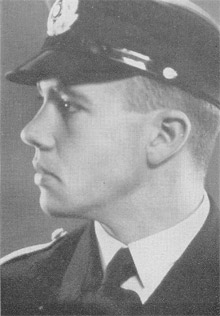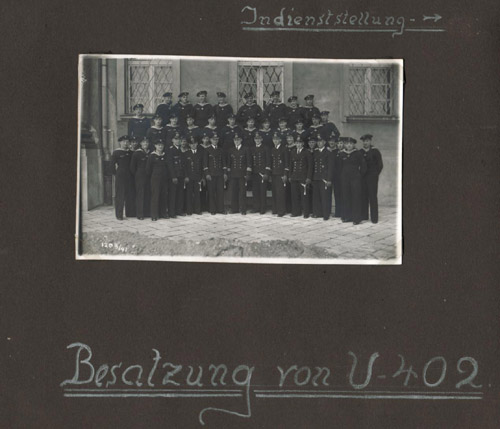13 October 1943, 12.22: The End of U-402's Charmed Career
by Marc-André Haldimann
Korvettenkapitän Siegfried Freiherr von Forstner (1)
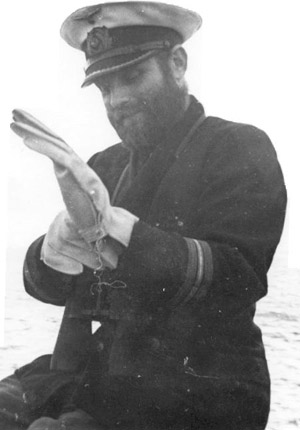 KK Siegfried Freiherr von Forstner photographed aboard U-402 in May 1942, during the third patrol. Courtesy of Mike McCarthy. |
|
The sinking of U-402 inaugurates a new type of narration in our exploration of lost U-boats; sunk with all hands, the story of its last patrol will never be fully known. This all too common occurrence should not be a deterrent: taking into account all the recorded information, a quite precise investigation of her last Feindfahrt is possible. The events leading to this sinking are already mentioned in some publications: besides William T. Y'Blood's Hunter-Killer (1983), which provides a valuable account of the American actions leading to the destruction of U-402, a precise narration of the attacks carried out by RAF against this boat on 7 and 8 September, 1943 is given by Norman Franks and Eric Zimmermann's U-boat versus Aircraft (1998). Though more general and not exempt from some errors, both Geoffrey Jones's Autumn of the U-boats (1984) and Kenneth Wynn's U-boat Operations of the Second World War (1998) present useful summaries of U-402's patrols. Finally, John Waters' Bloody Winter (1967) gives a remarkable account of Siegfried Freiherr von Forstner's life and career; concentrated in Appendix IV, Profile of an Ace, his work provides our sole insight into the human side of this story.
The idea of presenting the existing documentation came from various contacts with Mike McCarthy, whose uncle Joseph B. McCarthy lost his life aboard USS Cythera (PY 26), torpedoed on 2 May, 1942 by U-402. Through close contacts with James M. Brown, one of the two survivors who were taken aboard U-402 and brought back to captivity in Germany, and by visiting NARA, Mike painstakingly collected the available information on USS Cythera and on U-402. Giving me his full support for this work, Mike generously provided the full Antisubmarine Action by Aircraft Report (ASW-6 No. 29) written by Lt. Comdr. Avery, endorsed by Capt. A. J. Isbell, and some of the combat pictures conserved in the NARA (see Sources).
Once again, this study could not exist without the fundamental help of Jerry Mason (Uboatarchive.net) who unselfishly provided all existing NARA pictures for this action and for the attack conducted by VC-9 on 12 October. (2) He also unearthed the full ASW-6 reports drafted by Lt. (jg) Balliett on 12 October and by Lt. (jg) Fowler on 13 October narrating those unsuccessful attacks against U-402. My debt towards Axel Niestlé is no smaller: he provided a most generous access to his immense archives and a copy of the reconstructed KTB for U-402's last patrol 3, thus allowing the known events to be pinpointed. His patient answers to my numerous demands cannot be thanked enough. My thanks also extend to Hugh Alexander from the Public Record Office who kindly provided the Operational Record Books of 120, 172 and 612 Squadrons, thus allowing a reconstruction in detail of the attacks carried out by the RAF against U-402. I am similarly indebted towards Ilene McKenna from the Canadian National Archives who provided the Operational Record Book of 10 RCAF Squadron, together with the Weekly Intelligence Report File S.322-12 (CIO): Attack by Liberator X/10 BR, Sept. 22nd, 1943. Andreas Angerer and Horst Schmeisser were also instrumental for this study: they both sent the complete crew list through the U-board and the deutsche U-Boot Forum. (4) Ken Dunn kindly made available his files referencing all published pictures of U-402, providing also precious information about some of the ships sunk by her. Horst Schwenk, from the U-Boot Archiv in Cuxhaven, and Thomas Weis, from the Bibliothek für Zeitgeschichte in Stuttgart, were most helpful in tracing and kindly sending hitherto unpublished pictures of U-402 and her crew. As usual, my dear father, Frederic Haldimann, provided the available meteorological information. Finally, the correct appraisal of the general context in which U-402 conducted her last patrol could not have been correctly traced without the kind help of Klaus-Peter Pohland who also provided the boat's daily position between 4 September and 13 October, 1943. To all of them I extend my warmest gratitude and thanks.
Bleak prospects in the North Atlantic
U-402 led a charmed life during May 1943: though she left her base on 21 April, 1943 and spent almost the whole month of May in the North Atlantic, she survived all Allied ASW measures and managed to sink two ships before tying up at La Pallice on 26 May. (5)
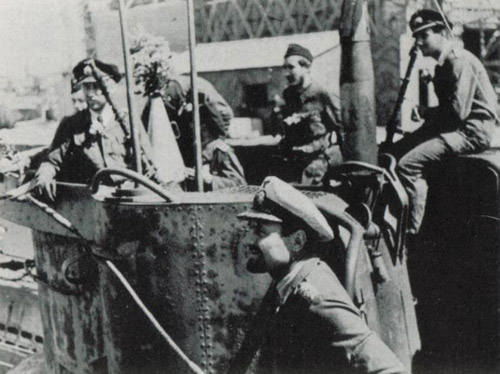
The last homecoming at La Pallice on 26 May 1943:
close up of U-402's conning tower with von Forstner standing in the
front, at the port edge of the Wintergarten. Herzog 1970, 205.
For her 49 crewmembers and their commander, Korvettenkapitän (KK) Siegfried Freiherr von Forstner, the end of their seventh Feindfahrt coincided with the implementation of the emergency measures taken by BdU to fight the overwhelming odds added up by the Allies against his boats. Since 24 May, 1943, operations against North Atlantic convoys had been suspended, pending a thorough review of the causes of the stunning loss of no less than 41 U-boats within 22 days, a period since then called "Black May ". (6)
Before the strategically sound decision of 15 August, 1943 to go to full production of the new Elektroboote designs (Type XXI and XXIII), which would be available at the earliest by November 1944, Dönitz and the Naval Staff committed themselves to implementing stopgap solutions to ensure a measure of efficiency and chances of survival for the old Type VII and IX boats until their withdrawal. (7) These urgent steps included defensive measures like the fitting of eight 20mm AA guns on a rebuilt conning tower (Turmumbau IV) and the installation of a new radar warning device, the FuMB 8 Hagenuk Wellenanzeigegerät 1 (W.Anz.g1 later contracted in Wanze I). (8) Dönitz also put highest priority on the crash production of a new offensive weapon, the acoustic torpedo T-5 Zaunkönig: he ordered 80 units to be ready imperatively for 1 August, 1943. Only after their effective and timely delivery to the French U-boat bases did he again authorise the sailing of his modernised boats to the Atlantic battleground, placing high hopes on their renewed efficiency. Thus began another pitched period of the Battle of the Atlantic; the 35 days of U-402's last cruise unfurled themselves among those high initial hopes and the bitter realization of their doom, obvious by the end of 1943.
Like most submarines in the French harbours, U-402 was fitted with a new Turmumbau IV conning tower with armoured side bunks, bristling with two double-barrelled 2cm 38 M II guns on the enlarged upper platform and a Flakvierling, a quadruple barrel 2cm 38/43 U gun with shield on the lower platform. This drastic superstructure modification was completed by a three month long thorough refit of the severely damaged boat (9); it included the installation of the new radar warning device FuMB 8 and an improved radar, the FuMO 30 GEMA-Seetakt, with its antenna housed on a retractable and rotating mast.
This protracted stay allowed long leaves for most of the crew. Von Forstner also left for his home in Hamburg where he could be reunited with his wife, Annamaria. Already shaken by his close escape on the previous patrol, the U-boat commander witnessed and survived the terrible Hamburg raids mounted by the RAF and the USAF on 24, 27, and 29 July and 2 August, 1943. During one of his last nights at home, Siegfried von Forstner told his wife about the possibility of not returning from a patrol (see introductory statement above). As he came back to La Pallice, he put aside his worries and dedicated himself again fully to his command and his crew. (10) Thus, as the re-equipped U-402 left her base at La Pallice on 4 September at 19.45 hours, KK Freiherr von Forstner, holder of the Knight's Cross, and his 49-man crew had some reason to believe in the success of their new patrol: they were ready, well equipped, and after all, they were a seasoned and efficient crew who claimed up to this point 15 ships for 71,036 tons. (11)
A Patrol Marred by Aircraft Attacks
The initial situation met by U-402 was not a comfortable one: the boat had to slip through the Bay of Biscay, which was monitored round the clock by RAF and Coastal Command antisubmarine patrols that had extracted a terrible toll from crossing U-boats between May and 2 August, 1943, BdU imposing that day a ban on all crossings of the Bay. (12) After having spent a fruitless month of August as a result, the Allies were eager to renew their earlier successes. Prowling those waters, they were transforming every U-boat operation there into a continuous nightmare for the watch crews; the Wanze monitoring only metric radar waves was no help against the Allied centimetric airborne radar, still not thought to be technically possible by the Kriegsmarine.
Only three days after having left La Pallice, while U-402 was running surfaced in position 46° 35' N and 09° 00' W (German naval square reference BF4597), she was picked up at 22.03 hours by the ASW radar of F/O T. Armstrong's Vickers Wellington Mark XIV serial MP791, "Q" from 172 Squadron operating out of RAF Chivenor. (13) Still six miles away from U-402, F/O Armstrong swiftly brought his Wellington down to 200 feet as there was no cloud and bright moonlight; he approached down moon within a mile from U-402 and switched on his Leigh light as he raced now at an altitude of a bare 50 feet towards his target, his front gunner opening fire on the brightly illuminated conning tower. The lookouts aboard U-402 were certainly an efficient team, as less than 5 seconds after the Wellington's front turret opened fire, the plane's crew noticed machine gun and cannon return fire. Its path set at an angle of 90 degrees to U-402's track, the Wellington released from port to starboard six depth charges at 22.05 hours and climbed away turning while making evasive maneuvers, its rear turret firing on the boat until it was obscured by two large explosions. Circling out of reach from the boat's AA armament, Armstrong noticed U-402 was now on a zig-zag mean course of 315º at about 8 to 10 knots. After ten minutes, the crew of MP791 managed to get close enough to their target to drop a marine marker and a flame float. Ten more minutes elapsed before F/O Armstrong decided on a second run-in; with no more depth charges, he had to be content with strafing his target from a height of 100 feet, the Wellington being chased by the boat's return fire.
As Armstrong circled the boat afterwards some four miles away, he saw at 23.14 hours another Leigh light open up at a very low altitude, while streams of tracers from U-402 were reaching out towards the light. A few seconds later, the light spread out into a circle and developed into a fire, soon blotted out by a large explosion which seemed to take place directly over the boat. Those were in all probability the last moments of fellow Wellington "D" serial MP509 piloted by F/O C. J. Payne, also from 172 Squadron. Caught in the accurate fire put up by the two twin 20 mm guns from the upper platform and the quadruple 20 mm guns on the lower Wintergarten, the Wimpey, as this type of plane was nicknamed by their crews, caught fire and crashed shortly afterwards into the sea, where escaping fuel burned for 20 minutes. Though unaware of being also hit in the port undercarriage, Armstrong, now deprived of any offensive capacity, reported the sighting in the vicinity of the attack of another aircraft flying at sea level at 23.36 hours, and then turned back towards base. Despite the port tyre shredding upon landing at Chivenor, F/O Armstrong made a safe landing and only then noticed that his plane had been hit twice by U-402's accurate fire.
Undoubtedly elated by their success, U-402's crew settled again on the tedious task of progressing through the hostile wastes of the North Atlantic to reach their designated patrol area in naval square reference BE 5820. The boat's relief was short-lived: on 8 September, 1943, at 05.15 hours, Wellington "M" serial HF126 of 612 Squadron, piloted by F/O J. M. Bezer, picked her up on its scope at four miles while flying a Percussion J 2 patrol. (14) After tracking over their target at 600 feet, the rear gunner spotted the boat's wake. Bezer flew on for three miles before turning and taking his plane down to 100 feet; while 3 quarters of a mile away, he switched on the Leigh light, U-402 immediately reacting by opening fire with her full AA armament. Fortunately for the boat's AA crew, the front gunner's weapons jammed while Bezer bore down on them at a height of only 50 feet. Again, U-402's gun crew was accurate; seconds before the release of six depth charges aimed at the conning tower, shells smashed the Perspex glazing of the Wellington's nose, slightly injuring the pilot, and hit both engine nacelles, the starboard wing tank and the radar equipment. Unable to check out for himself the result of his attack, Bezer immediately had to nurse back his stricken machine, his rear gunner reporting one large explosion plume alongside of U-402, still on its original course and surfaced while her AA fire ceased. At 06.02 hours, after half an hour's flight toward home, F/O Bezer had to cut the starboard engine and successfully feathered the windmilling propeller while his crew started jettisoning all excess equipment but the magazine of the camera in order to keep height. I.F.F. switched on the distress position, Bezer managed to keep his Wellington airborne on one engine for 90 long minutes, eventually crash landing at Portreath at 07.30 hours with no injuries to his crew and with nothing to show for his gallant attack: the preserved camera magazine broke open on impact, spoiling the film.
Proceeding towards his assigned patrol zone, von Forstner, well briefed for the dangers HF/DF represented to his command, kept a rigorous radio silence until 11 September. At 22.58 that day, he sent the following message: "No contacts until now. Air attacks in BF48. 1 shot down." This sibylline message moved the BdU staff to send a long reply enumerating the possible sequence of events as decrypted from Allied transmissions intercepts and requesting eventual corrections to be given in the next necessary transmission. (15)
"Leuthen" and "Rossbach": A Frustrating Convoy Battle and an Empty Ocean for U-402
On 15 September, U-402 and 19 other U-boats were directed to form a patrol line across the great circle at about 25° west. This new pack, code-named "Leuthen", had to be in position by 20 September at 16.00 between naval square AK 5441 and AL 4762 (SSW of Iceland) in order to intercept one of the ON - ONS convoys along its most probable route. (16) Warned of the impending pack menace by Enigma transcripts on 18 September, Admiralty re-routed the 41 ship strong ON-202, protected by 7 escorts (Canadian Escort Group C-2, Commander P.W. Burnett), to the north-west in hopes of avoiding "Leuthen". (17) However, on 19 September, the sighting and subsequent destruction of U-341 by Liberator "A" 586 of 10 RCAF Squadron (18) in the vicinity of slow convoy ONS-18 raised considerable alarm: "Leuthen" was stationed much further north than expected and ON-202 was bound to run right into the forming pack. The inevitable happened earlier than expected by Dönitz: U-270 reported the convoy at 04.00 hours on 20 September, thus triggering from BdU at 05.00 hours an order to attack at once for the whole pack. U-402 was among the first boats of "Leuthen" to make contact: while in naval square AK 3948, von Forstner reported at 16.10 an attack against a destroyer, the torpedo missing aft because of the target's high speed. He also confirmed the BdU estimate for the incurred air attacks on 7 and 8 September and that he had 95 cubic meters of fuel left. (19)
Unbeknownst to him or BdU, he was like all "Leuthen" boats now confronted with ON-202 and ONS-18, the former convoy having been instructed to join up with the latter. U-270's successful attack on the frigate HMS Lagan moved the Admiralty to issue this order and to summon an escort group to beef up the seriously overburdened defenders. From 20 September at 16.00 hours onwards, the 20 surviving boats of the Leuthen group were now confronted with 66 merchants and 15 escorts. (20) The first phase of this pitched battle lasted until 21 September; while U-270, U-305, U-645 and U-952 managed to sink HMS Lagan, HMCS St. Croix, HMS Polyanthus, SS Frederick Douglass and SS Theodore Dwight Weld, U-402 could not break through the escort screen. A dense fog shrouded the ailing convoy from early 21 September until noon the following day, curtailing any offensive activity. At 02.40 hours on 22 September, U-402, with 77 cubic meters of fuel left, radioed from AK 4657 that she was monitoring an escort ship via her hydrophones. At 15.00 hours, from naval square AK 7226, she sent a meteorological report and at 18.55, von Forstner acknowledged his loss of contact with the convoy, despite the much improved weather conditions. (21)
The favourable weather conditions again allowed constant air cover, which showed immediate results: five U-boats were sighted or attacked around ONS-18/ON-202 in less than 4 hours. (22) Though undetected at first, U-402 also came under attack after witnessing the punishing strike delivered by Liberator X of 10 RCAF Squadron against U-377. (23) Under the command of KL Gerhard Kluth, this boat was detected dead ahead at 18 miles by the Liberator's radar and subsequently sighted at 19.43 hours at a distance of 7 miles in position 53º.17'N/37º.29'W. The Liberator's skipper, Flight Lieutenant J. E. Martin, took his command down to fifty feet and dropped four 250 lb. depth charges which bracketed the bow of U-377 before being driven away by heavy AA fire. After eight minutes, as Liberator X prudently circled at about three miles, U-377 seemed to settle without forward speed. Still kept at bay by fierce AA fire even though only the conning tower was above surface, F/L Martins waited for the boat to definitely submerge before launching his second attack, dropping two FIDO torpedoes 20 seconds after the conning tower vanished. 90 seconds later, at 20.02 hours, as an oily patch 75 feet by 100 feet was observed, U-402 was sighted at this very moment by the crew of the Liberator at a distance of 7, 5 miles in position 53º.24'N/37º.28'W; the boat was heading towards the scene of the first attack at a speed of 10 knots. While F/L Martins banked his aircraft to engage the new enemy, KK von Forstner ordered his AA gunners to open fire from a distance of three miles at the incoming Liberator; (24) the heavy eight 20 mm gunfire forced F/L Martins to employ evasive tactics while the top and rear turrets together with the side guns returned fire from a distance varying between 1200 to 2000 yards. Von Forstner's spirited fight was evident for the Canadian crew which, now deprived of depth charges, had little means of damaging the boat: they noticed in surprise how U-402 repeatedly tried to close the range, turning continually towards the aircraft. After several minutes, the boat took advantage of a nearby fog bank to put an end at this unprecedented aircraft chase. (25)
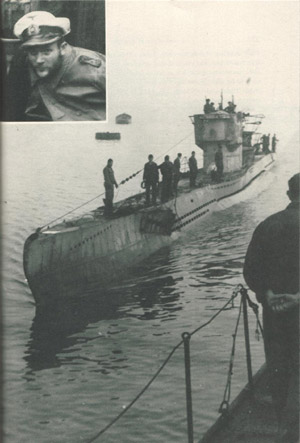 U-377 limping home in Brest on 10 October 1943, with her bows damaged by Liberator X of 10 RCAF Sqn. In the inset: U-377's wounded Kaleu, Gerhard Kluth (Jones 1984, 171). |
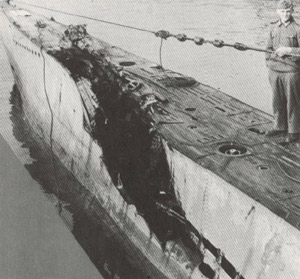 Close-up of the damage done by Liberator X of 10 RCAF Squadron (Jones 1984, 18). |
Von Forstner drove on with his command in search of the convoy. At 23.00 hours, U-402 signalled the lack of any homing signal and at 02.30 hours on 23 September sent a short meteorological report while searching on a south-western heading. (26) As U-238, U-666 and U-952 managed to bag HMS Itchen, SS Oregon Express, SS Skjelberg, SS Steel Voyager, and SS Fort Jemseg, and damaged SS James Gordon Benett, U-402 searched without success for another 24 hours. By that time, Dönitz and his staff, elated by the apparent sinking of 12 escorts and 9 merchant ships, had already called off the "Leuthen" pack: in the early hours of 23 September, ON-202 had reached the fog area north-east of Newfoundland and was from then on out of reach. (27)
Expecting orders, U-402 sent a short meteorological and status report at 00.35 hours on 24 September. (28) Assuming that the Allies were logically expecting "Leuthen" to form a new patrol line around the Newfoundland Bank and try to intercept another SC or HX convoy, BdU issued a new order at 16.45 hours based on the latest radio decrypts: U-402 and 18 other boats were to move nearer to Greenland and form a new pack code-named "Rossbach" to be positioned by 26 September at 16.00 hours in a patrol line from naval square AK 2645 to AK 6817. (29) The northward move was intended to intercept the next ON-203 and ONS-19 convoys, thus hopefully surprising the Allied convoy planners. This development also caused some trouble for U-402's navigation, the boat lacking the relevant reference point hidden behind the code-name "Ysop". (30) After finding his bearings, von Forstner took up his planned position while his bridge watch took up the desperately dull task of scrutinising the horizon through their powerful Zeiss 7 x 50s binoculars in the hope of seeing tell-tale wisps of smoke or even masts. At the same time, they had to be on the alert, trying to spot the small speck in the sky, which in a matter of a few moments could turn into a low flying carrier aircraft or VLR patrol plane boring down on their boat.
Based as before on the latest radio intercepts, BdU repositioned the "Rossbach" boats 160 kilometres to the north-west, sending his order at 11.35 hours on 27 September. Confronted again with the lack of interception, Dönitz concentrated on a new tentative plan to catch the next convoys, ONS-19 or ON-204; to achieve this result, the "Rossbach" pack, reinforced by U-309 and U-631, was ordered on 29 September to move towards the north-east, their definitive patrol line being given at 23.51 hours on 30 September. (31)
Time ticked away as U-402 cruised, her lookouts on alert, the improving meteorological conditions a sure warning for Allied air patrols. Those weren't long in coming. At 08.35 hours, the heavily laden Liberator III "T" from 120 Squadron lifted off from Reykjavik and set course towards convoy HX 258. (32) Half an hour after flying over a lone freighter, F/Lt G. L. Hatherly and his crew sighted U-402 on the surface at 12.01 hours. Sounding the alarm, Hatherly took the Liberator in a dive towards the boat and ordered the bomb bay doors opened. To his utter dismay, nothing happened; the doors were jammed. Meanwhile, U-402's efficient gun crew was putting up a "considerable amount of Flak". This spirited defence, combined with the Liberator's nose guns jamming too, led F/Lt. Hatherly to abort his attack run and retreat, trying to troubleshoot the technical failures besetting his command. As the bomb bay stubbornly remained unserviceable, there was no choice left but to resume the patrol, which lasted until 15.19 hours. By that time, as Liberator "T" took his return course, its crew had additionally sighted and strafed U-305, and sighted the surfacing U-448, without being able to deliver the eight depth charges stored in the still jammed bomb bay. U-402, resuming her search for the convoys, was overflown three hours later, at 19.52 hours, by another Allied patrol plane which remains yet to be identified. (33)
Thanks to Enigma decrypts, Western Approaches re-routed the endangered convoys, leaving a desperately empty ocean for all U-boats during the next four days. (34) The only break in the tedious patrol routine was the new BdU directives shifting the luckless "Rossbach" group onto new headings based on the usually efficient B-Dienst advisories. (35) At 18.03 hours on 4 October, Dönitz, sensing the uselessness of this search, sent the group to the south-west against the eastbound convoys.
Fully aware of the impending menace, the Admiralty diverted HX-259 far to the south and sent the four destroyers of British support Group 10 to reinforce the nine escorts (Canadian Escort Group C-2) and 39 merchant ships of convoy SC-143, using them as bait to lure the "Rossbach" group and hopefully wipe it out. (36) Time elapsed without any observation until 7 October: U-731 sighted two eastbound destroyers in the evening. This matched the expectations of BdU well: "Rossbach" was planned to intercept convoys HX-259 or SC-143 at approximately 30º West on 8 October from midnight onwards. During the night, no less then 8 boats sighted destroyers on north-east headings, prompting a Luftwaffe aerial reconnaissance carried out for the first time by a new giant Blohm & Voss BV 222. Though the plane found the convoy immediately, it was unfortunately one and a half hours ahead of schedule, and his 30 minutes homing transmissions were thus not received by any U-boat. Despite being provided shortly afterwards with the precise position of the convoy, not a single boat could reach the convoy, which slipped away unharmed.
Of Fuel Shortage and Enigma Decrypts
As seen above, the flare-up of U-boat activity after almost 4 months of withdrawal from the North Atlantic at first caught the Allies by surprise. The reaction was swift, however; by the beginning of October, countermeasures were in full swing. Of paramount importance was the systematic tracking down of the "Milchkühe" type XIV U-boats, essential for keeping a large force of Front boats in their operational area. Monitored closely by the Enigma team at Bletchley Park, the radio traffic between Dönitz and his commanders led Western Approaches to send Task Group 21.14 to investigate the meeting points for refuelling. This force, centred on the escort carrier Card (CVE 11) and Composite Squadron VC-9, had a screen of four destroyers, the USS DuPont, USS Borie, USS Barry and USS Goff. Having left Hampton Roads on 25 September, the Task group, commanded by Captain "Buster" Isbell, first protected convoy UGS-19 before being redirected into the deep Atlantic to run down the "Rossbach" pack. The first successes came on 4 October when VC-9 planes spotted and attacked U-264, U-422 and U-455 while they were refuelling from U-460. In the ensuing fierce action, U 422 was sunk, U-460 lost to a diving accident and U-264 heavily damaged. (37)
From 7 October onwards, the weather turned bad; rain squalls and low ceilings were frequent while high seas formed. Even in those ditficult conditions, VC-9 kept constant air patrols, while U-402 and her fellow boats of "Rossbach" group were stalking an empty ocean whipped up by ferocious winds. Her fuel supply now running out fast, U-402 was instructed on 10 October at 13.04 hours to retreat towards BD 2685 in order to be refuelled by U-488, the last U-tanker still in operation; while on a southern heading it was desperately recalled after the sinking of U-460. (38)
The prevailing bad weather protected U-402 from sighting until 12 October. Though it was also a very foggy and misty day with a cumulus ceiling at 1200 feet, slight drizzling rain and a very rough sea cropped up by a 28 knots 268º wind, it didn't deter VC-9 from conducting air patrols.
Lt. (jg) Balliett, flying his VC-9 TBF1-c Avenger at 150 knots, was skimming the base of the cumulus ceiling on a 108º course on the return leg of his first sector of patrol as his radioman ARM2c J. H. Finch saw U-402 breaking surface at 12.20 hours on a 288º course only a mile and a half away in position 49º23'N/30º08'W. (39) As the boat's course was almost opposite to that of the Avenger, Lt. (jg) Balliett immediately swung his Avenger hard to the right in order to conduct a FIDO attack, but had to change plans, the boat now running fully surfaced. As he put his Avenger in a climb to gain enough height to drop his 500-pound bomb while telling his crew to warn him if the boat started to dive, the watch crew aboard U-402 noticed the lone plane. The boat, buffeted about by the rough sea, made a right turn for a short time, then again began a right turn. KK von Forstner, seeing the plane climbing and realising it was impossible for his AA crew to aim accurately in those sea conditions, took his chance and ordered a crash dive as his command straightened out on a 268º course.
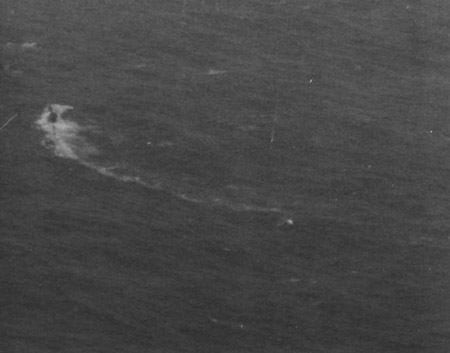 NARA VC9-25-1: one of the five pictures conserved at NARA, taken by the crew of Lt. (jg) Balliet on 12 October at around 12.23 GST in position 49° 23N /30° 08W. U-402, surprised by the VC-9 Avenger veers sharply to starboard (courtesy of Jerry Mason). |
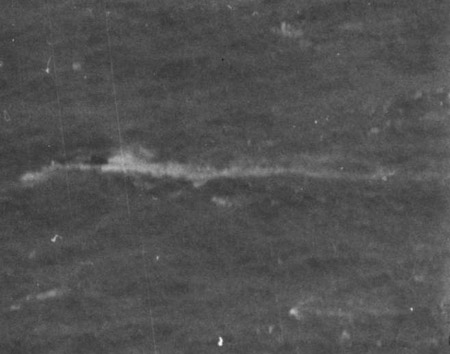 NARA VC9-25-2: U-402 at flank speed with heavy swells breaking over her bow. Though taken from afar, the distinctive shape of the Turmumbau IV conning tower can be recognized. (courtesy of Jerry Mason). |
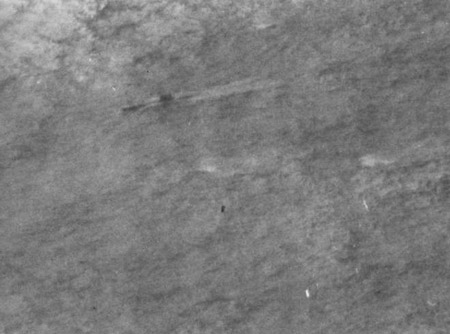 NARA VC9-25-3: U-402 seen in a glimpse of sun breaking through the clouds. Shortly after this picture was taken, the boat crash-dived, escaping for the last time. (courtesy of Jerry Mason). |
Balliett was then at 3,000 feet, about to start his bombing run, when his crew warned him that U-402 was diving; he therefore immediately turned toward the boat and lowered his wheels and flaps, skidding his plane violently in order to lose altitude without circling or picking up speed. As he stabilised his plane at 150 feet and 110 knots, U-402 was already almost submerged. Balliett steered up the boat's track from astern and, some 20 seconds after the conning tower disappeared under the waves, released his FIDO 100 to 150 feet dead ahead of the diving swirl. About a minute after release, radioman Finch and gunner AOM2c R. L. Goodwin both saw a smooth circular patch of water covered with foam, some 50 feet in diameter, persisting for half a minute. AOM2c Goodwin, his gun locked on safe, triggered his gun camera and took 16 pictures showing distinct water plumes in this area. This evidence led to the belief the attack was successful and the boat sunk. Actually, the acoustic torpedo was unable to lock on its target and did not inflict any damage. Ironically, the crew of U-402 remained unaware that they had suffered an attack: after surfacing again, the short message sent from naval square BD 2685 mentions only their sighting by a plane. (40)
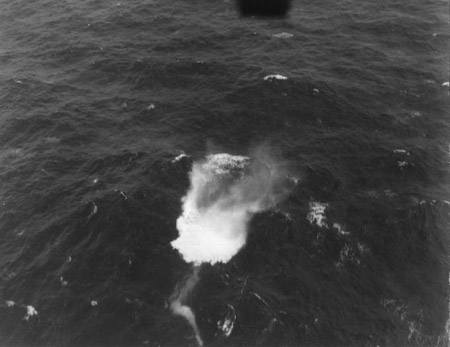 NARA VC9-25-4: Lt. (jg) Balliet handled his Avenger efficiently, bringing the plane on the U-boat's diving swirl some 20 seconds after the conning tower disappeared. This picture was taken by Balliet's radioman ARM2c J. R. Finch and shows the splash made by FIDO as it veers to port. The torpedo can be seen on the lower center edge of the picture. The effects of the heavy swell is noticeable on the wildly pitching bubble trail left by the FIDO. (courtesy of Jerry Mason). |
As a consequence of the intense air activity, at 20.27 hours that same day BdU changed the refuelling point to naval square BD 6195. (41) Night fell on the Atlantic, providing a measure of relief for U-402, which could run on the surface without being challenged, thus keeping her batteries charged and a full compressed air supply.
The last run
13 October, 1943 was an unfriendly day to be out in the North Atlantic: a 36-knot 250º wind roughed up the surface of the ocean, giving birth to heavy swells, with scattered rain squalls falling from an 8/10th cumulus overcast at 2500 feet. Early in the morning, USS Card launched her patrols; Lt. (jg) Fowler's Avenger, also manned by radioman AOM3c R. A. Burton and gunner ARM3c R. I. Goering was launched at 08.16 hours. (42) After fruitlessly patrolling his first sector, Fowler set off for the first leg of his second sector. At 09.21, as he flew out of a rain squall on course 321º at 1000 feet and 150 knots, he sighted U-402 ploughing her way through the heavy swells three miles away on his starboard bow on a 135º heading in position 49º06'N/29º47'W. Fowler was at first unable to figure out if the U-boat was in the process of diving, but as his Avenger was suddenly bracketed by a Flak burst, he logically elected to attack with a 500-pound bomb. He immediately put the Avenger into a climb and circled to starboard astern of U-402 before levelling off at 2500 feet. Boring down on the rolling boat, Fowler made his attack run only to find that the release mechanism of his bomb was not working. As he climbed again to 3000 feet for the next attack, he saw U-402 crash-dive after having radioed a short message reporting her plight to BdU. (43) Lt (jg) Fowler saw her dive and didn't hesitate; he immediately lowered his landing gear and flaps, and performed wild manoeuvres with his Avenger, losing speed and altitude in order to drop his FIDO torpedo. Fortunately for von Forstner and his crew, Fowler came over the diving boat in an awkward position and slightly fast; after a tight circle he was again on the right heading but quite late as he zoomed over the U-402's diving swirl a full minute after the conning tower disappeared, releasing his FIDO 450 feet ahead of it from a height of 175 feet. The acoustic torpedo couldn't find the submarine in the rough waters, allowing it to escape with less than two hours left to live. (44)
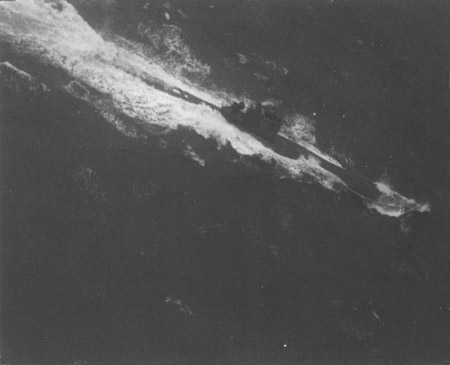 NARA 80 G 227947 : 13 October 1943, 12.10: As Avenger "9" passes on the starboard side of the boat, radioman ARM2/c H. R. Shirley shot this clear picture of U-402. A close scrutiny shows that the watch crew already reacted to the sudden appearance of VC-9's plane: the twin 20 mm guns of the upper platform are already manned, while the first man of the quadruple 20 mm gun crew races towards his station. The heavy swell breaking over the boat's bow is obvious in this shot. It misled Lt. Comdr. Avery in believing that U-402 was crash-diving, thus foiling his first attack (courtesy of Jerry Mason). |
As soon as Fowler radioed his sighting report, Lt. Comdr Howard M. Avery, radioman ARM2/c H. R. Shirley and gunner AMM2/c C. D. Falwell were launched at 09.29 hours aboard their TBF-1C Avenger (code number 9), to provide help. After reaching the spot where U-402 previously had dived and relieving Lt. (jg) Fowler at 09.40 hours, at 09.53 hours Lt. Comdr. Avery and his radioman both noticed a 300 foot long and 20 to 30 foot wide oil slick with the yellow and white spoiler boards of the Fido torpedo floating at the downwind end of the slick. Three photographs of the scene were taken at 10.00 hours by radioman Shirley, as Lt. Comdr. Avery felt those scant traces were proof enough for a sinking. (45)
Avery was ordered to remain on station and apply a waiting tactic called "Gambit". (46) This procedure heralded success, as at 12.09 hours, while travelling at a height of 1400 feet on course 160º at 120 knots, he saw the fully surfaced U-402, some 12 miles away from where Lt. (jg) Avery had made his previous attack. The boat was at that time travelling on course 180º at 10 knots, some 4 or 5 miles away from Avery's Avenger which was just passing through a moderate rain squall in position 49º56' N/29º41'W.
Seeing heavy seas breaking over the bow of U-402, Lt. Comdr. Avery thought the boat was submerging and immediately turned toward the boat while losing height and speed in order to drop his FIDO torpedo. Set on a 210º course, he approached U-402 from astern and, when only 500 yards away, realised the boat was not diving and that he was too close to break off his attack. He thus elected to remain on course and pressed on, strafing his totally surprised target. As he passed on the starboard side of the boat, he saw the watch crew in the conning tower and a lone Ubootmann training his gun against the plane. He had also time to notice the black and rusty appearance of U-402 with her deck a reddish brown colour while radioman Shirley shot two pictures as they flew by. Though not sure if any Flak was actually put up against his Avenger, Avery retreated violently jinking his plane in order to avoid being hit.
As Avery climbed away, U-402's full gun crew, who had already frantically taken position behind their eight 2cm AA guns and introduced the ready ammunition into their weapons breeches, were opening fire on the now circling plane. Von Forstner's watchkeeping radioman, either 21 year old Funkmaat Franz Kollinger or 19 year old Funkgefreiter Franz Kullmann, was quicker than radioman Henry R. Shirley to signal the action: at 12.10 hours, the U-boat got out her last message to BdU: "From U-402: am attacked by aircraft". This was the fifth of its kind since leaving La Pallice and the second in less than three hours.
While his pilot was orbiting Avenger 9 around U-402 hoping it would dive, radioman Shirley sent an amplifying report at 12.12 hours. By that time, the Flak crew of the boat was shooting well aimed salvoes at the plane which circled just out of reach; given the heavy swells rolling and pitching U-402, which was now running at dreimal AK voraus (full speed ahead), this was by no means a small feat for the Ubootmänner. Lt. Comdr. Avery had time to notice their excellent marksmanship, as he saw bursts of 15 to 30 20mm shells explode generally behind but sometimes ahead of or beyond his plane while he abruptly changed altitude between 800 and 1200 feet, altering his heading and speed to throw his tormentors off mark.
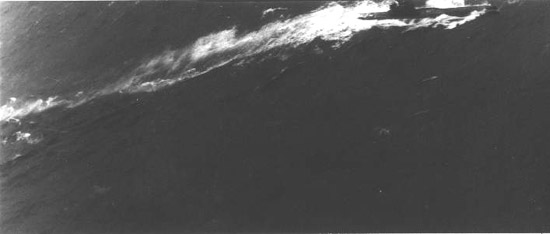 NARA 80 G 281696 : 13 October 1943, 12.10: This second photograph, also taken by radioman Shirley, shows U-402 altering her course to starboard, while the quadruple 20 mm gun is already trained towards the now retreating airplane. The violence of Avery's jinking to evade eventual AA fire is obvious: initially well centered in the camera's visor, the U-boat came almost off field as Avery abruptly lowered his port wing while Shirley hit the shutter. Actually, U-402's crew was not in a position to fire at the Avenger in this moment (courtesy of Jerry Mason). |
At 12.13 hours, ARM3c J. A. Blais, radioman aboard the patrolling TBF-1c Avenger 12, piloted by Ens. Barton C. Sheela while the gun turret was manned by gunner AMM2c L. E. Emmitt, got a transmission from USS Card ordering them to join up with Lt. Comdr. Avery and attack U-402. Sheela, then only 15 miles away, opened up the throttle and, while flying at 3000 feet and at 200 knots, at 12.17 hours he saw U-402 some six miles away running on a 225º course. He immediately put his Avenger in a climb, steering her in a position astern of the U-boat and pushed over from 4500 feet in a steep dive headed some 15º off her port stern. Fully concentrated on the circling Avenger 9, the Flak crew did not notice Sheela boring in at 12.20 hours, partially hidden by low clouds: not a shot was fired at Avenger 12 while it made its attack run. At a height of 1500 feet and at 300 knots, Sheela released his 500-pound Mark 12 bomb and pulled out of his dive. Gunner Emmitt saw the weapon impact the ocean some 800 feet ahead of U-402 while it made a hard turn to port; first failing to see U-402 when the Avenger zoomed overhead, radioman Blais managed to get a picture of the exploding Mark 12 ordnance with U-402 caught amidst her evasive manœuvre from the port fuselage window.
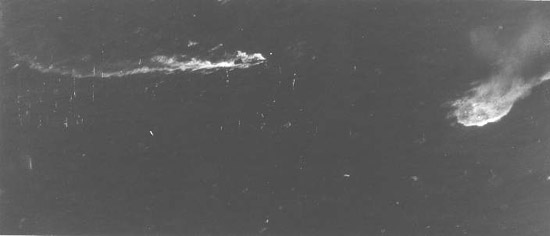 NARA 80 G 281694: 13 October 1943, 12.20: taken by radioman J. A. Blais from the port fuselage window of Avenger "12", this is the last picture of U-402. Blais, unable at first to sight the boat as Ens. Barton C. Sheela zoomed at more then 300 knots over his target, managed moments later to snap this picture. The explosion plume of the single 500-pound Mark 12 bomb subsides some 200 yards off the starboard bow of U-402 which, travelling at flank speed, alters its course to bypass the impact zone. Korvettenkapitän von Forstner probably just issued the fateful order to crash-dive as less than 40 seconds later, U-402 was totally submerged while Lt. Comdr. Avery closed in on its diving swirl, about to release his Mk 24 FIDO acoustic torpedo (courtesy of Jerry Mason). |
The sudden arrival of a second plane and its subsequent bungled attack while the first aircraft continued circling certainly induced von Forstner to believe that both Avengers were out of ordnance. His choice was from then on simple: confronted by two planes which seemed by now harmless, having expended their depth charges, and knowing that more reinforcement would certainly be dispatched, von Forstner decided logically to crash dive and sneak out of the zone travelling underwater. Thus, less then a minute after Sheela's failed attempt, both aircrews saw U-402, again running on her original 180º course, beginning to crash-dive. Aboard the boat, as von Forstner ordered her to be taken underwater, the four men forming the Seemännische Wache (watch crew), closer to the hatch, probably fell down the ladder to the Zentrale first, followed by the seven gunners of the AA guns from the Wintergarten, von Forstner being the last to leave the bridge as U-402 submerged, pulling the hatch and wheeling it shut as the water closed over her deck. Due to the haste, the diving angle was excessive: the stern remained visible for 5 or 6 seconds after the conning tower disappeared.
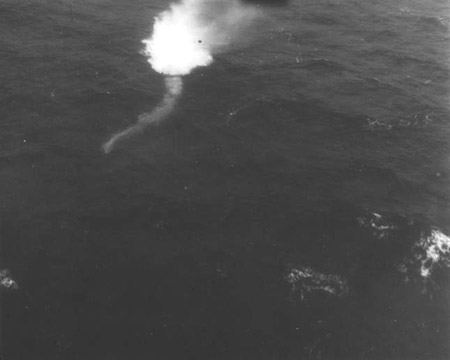 NARA VC9-29-2: 13 October 1943, 12.21: U-402 has just crash dived as radioman Shirley aboard Lt. Comdr. Avery's Avenger 9 took this picture showing the splash and the start of the Mark 24 FIDO underwater. Note that this time the run is perfect: the depth of the torpedo is stable and her acoustic sensor, locked on U-402's propellers noises, makes it swerve towards the diving boat. Some twenty seconds later, the weapon hit U-402 (courtesy of Jerry Mason). |
Flying at about 800 feet some 2000 yards away from U-402, Lt. Comdr. Avery lost no time when he saw her dive. He immediately put on full power and closed to about 1000 yards before cutting off his throttle and lowering his landing gear while the stern of the boat still showed. Rapidly losing airspeed to 130 knots, Avery attacked on a 225º course at a height of 200 feet, dropping his FIDO some 100 feet up U-402's track and about 75 feet to the starboard of the swirl. At 12.21 hours, radioman ARM2c Shirley was able to shoot a picture of the Mark 24 "Mine" just after it hit the water and started running and turning to port. About 20 seconds later, the fate of U-402 was sealed: the FIDO hit her, with great probability between the conning tower and the stern, its acoustic sensor locked on the noise of her churning propellers. (47)
From above, both Lt. Comdr. Avery's gunner, AMM2c Falwell, saw a shock wave some 200 feet ahead and to the right of the swirl; the impact was also seen by Ens. Sheela, who described it like "a piece of jelly with a fire cracker under it". Her starboard saddle tank torn open, her pressure hull fatally holed, there was just no possibility for the Leitender Ingenieur, 24 year old Hermann Harthe, to stop the inrush of water and try to surface U-402.
Aboard Avenger 9, Lt. Comdr. Avery circled to the left and took the plane back over the spot where the concussion was seen. All the crewmembers saw large oil slicks reaching the surface as they passed overhead and dropped a dye marker. Ens. Sheela was directed soon afterwards, at 12.25 hours, to resume his patrol while Avery kept on circling the place of sinking for a while longer. After five to six minutes, three cylindrical objects surfaced in the oil slick; they were steel coloured, about 2-3 feet wide and 15-20 feet long with one side painted white. Those objects were probably the two compressed air bottles from air group 1, the third cylinder being probably the bottle powering the stern torpedo tube. In all cases, their emergence on the surface narrows the impact position of the FIDO to a location on or near the E-motors compartment.
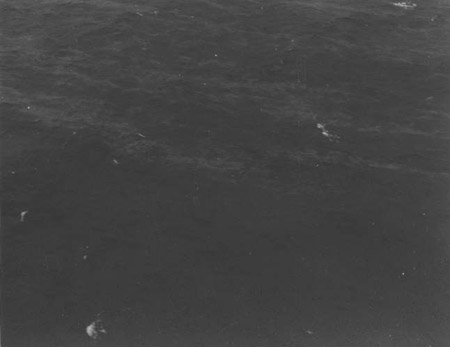 NARA VC9-29-3: 13 October 1943, around 12.30: all what remains from U-402 and her crew. Again taken by radioman Shirley from Avenger "9", this picture shows the large oil slick which rises to the surface, together with 3 cylindrical objects, one on the lower left, the two others on the upper right. They probably are compressed air bottles from air group 1 and from the stern tube operating mechanism. (courtesy of Jerry Mason). |
After his gunner C. D. Falwell took some pictures of the floating objects, Avery was directed at 12.35 hours to head back for USS Card, leaving this now empty spot in the Atlantic Ocean. Thus ended the last patrol of U-402. Posted on 10 November as missing effective 22 October, 1943 (Vermisst ein Stern), it was considered definitely lost on 5 July, 1944 (Vermisst zwei Stern). (48)
The implications of her loss and that of the other 11 boats sunk since the "Leuthen" group started operating on 20 September were yet to be recognised by BdU. (49) As late as 1 November, Dönitz and his staff still believed a U-boat with eight 20mm gun had a chance to fight it out against planes. Further, he considered the "Rossbach" group's failure to locate the five targeted convoys to be the result of faulty positions transmitted by Luftwaffe reconnaissance combined with poor navigation from his U-boats. (50) These were flawed deductions: his boats failed to find the convoys which were re-routed thanks to Enigma decrypts, or were forced underwater by superior ASW measures, centimetric radar and the air supremacy of the Allies. BdU would only recognise some of those aspects later, especially the fact that, no matter what amount of guns, a U-boat would never be an efficient AA platform.
Marc-André Haldimann
Appendix I
The greatest danger for the U-boat proceeding independently is enemy aircraft. Surprise attack may come (1) during the day with medium to heavy overcast sky or low-hanging clouds with medium to poor visibility; (2) during the night when there is clear, calm weather, bright moonlight, and phosphorescence.Planes generally fly at low altitudes in the North Atlantic at about 2,000 meters, and therefore do not come into sight at the horizon but rather at an angle of 30-40 degrees. For the sector in which the sun is standing, use very dark glasses. When the sun is low have one lookout with glasses facing the sun, one without glasses away from the sun.
When proceeding on the surface have the antiaircraft guns always ready for use, that is, cocked and put on safety, magazine attached, and cranked to point high.
Allow only the most essential personnel on the bridge. The Commander will admit additional numbers in exceptional cases. No outside exercise programs are permitted.
For the boat to dive safely in an aircraft situation, the plane must be at least 8,000 meters distant. If in doubt remain surfaced. During a recent surprise attack on a group of three U-boats, one boat made the mistake of submerging. It was bombed while diving and lost. The surface defense of the others was successful. Moral: When surprised stay above and shoot. Diving is death.
There are still boats that during surprise aircraft attack submerge at the moment the plane flies over the boat. This procedure is incorrect and mortally dangerous. Even the largest planes and flying boats are on the spot of the swirl again after a minute to renew the attack. In this length of time no boat can reach a safe depth, especially if a large num-ber of men have been on the bridge for A/A defense.
Only those boats that constantly anticipate all possible defensive situations, plan their roles accordingly, keep prac-ticing and improving them, and carry them out with unrelenting strictness will successfully overcome the enemy defense. On cruise out and cruise in the main task of the Commander is to get his boat through unendangered. Just passing the time of day is punishable levity.
BdU Admonition message (51)
Appendix: Daily position of U-402 on her last patrol (courtesy of Klaus-Peter Pohland)
04.9. from La Pallice 19h45
05.9: naval square BF 67
06.9:
naval square BF 83
07.9: naval square BF 81
08.9: naval square BF
48
09.9: naval square BE 69
10.9: naval square BE 68
11.9:
naval square BE 59
12.9: naval square BE 58
13.9: naval square BE
54
14.9: naval square BE 54
15.9: naval square BE 46
16.9:
naval square BE 13
17.9: naval square AL 75
18.9: naval square AL
60
19.9: naval square AL 50
20.9: naval square AK 19
21.9:
naval square AK 46
22.9: naval square AK 72
23.9: naval square AK
71
24.9: naval square AK 47
25.9: naval square AK 55
26.9:
naval square AK 52
27.9: naval square AK 27
28.9: naval square AK
18
29.9: naval square AK 18
30.9: naval square AK 27
01.10:
naval square AK 03
02.10: naval square AK 38
03.10: naval square
AK 38
04.10: naval square AK 30
05.10: naval square AL 10
06.10: naval square AK 63
07.10: naval square AK 69
08.10:
naval square AK 93
09.10: naval square AL 48
10.10: naval square
AL 74
11.10: naval square BD 31
12.10: naval square BD 26
13.10: naval square BD 2938, sunk at 12.21 hours.
This article was published on 23 Sep 2002.
